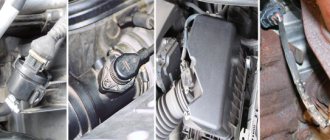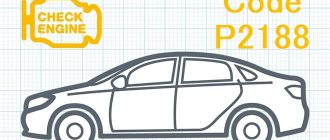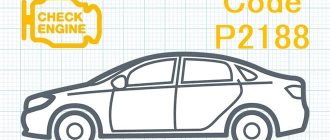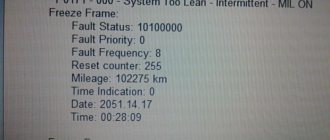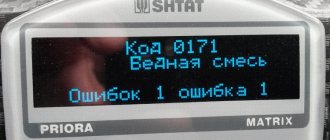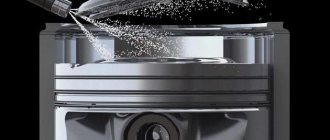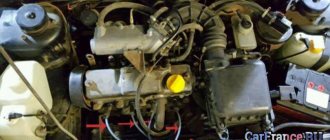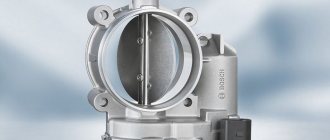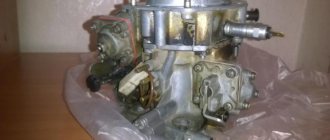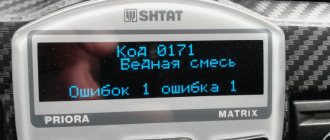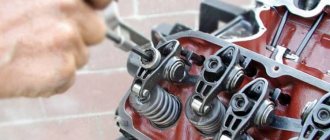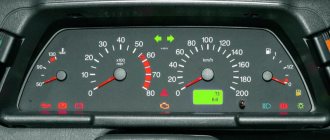Error p0172 means too rich mixture (or system too rich). Thus, a re-enriched fuel mixture is supplied to the combustion cylinders. Like the P0171 code, the rich mixture fault is systemic. That is, it does not indicate an obvious malfunction of the sensors, but the fuel quantity parameters exceed the limit value.
Depending on the reason that caused the appearance of such an error code, the behavior of the car can also be different. In some cases, noticeable fuel consumption will appear, and in others, only choking at idle or floating speed either on a hot engine or when it is still cold.
Error conditions
The engine must be started and the fuel supply occurs with feedback from the oxygen sensor (lambda probe), and there is no error from the coolant sensor, intake air temperature sensor, absolute pressure (MAP - sensor), DPPV, DPKV and throttle position sensor. When the average of the total short-term and long-term fuel trim values is less than 33% for just over 3 minutes out of the 7th test period. The indicator light on the instrument panel will go out only if the diagnostics does not detect a failure after three test cycles.
Codes related to P0172
When diagnosing trouble code P0172, you may also encounter other errors:
- P0170 - the fuel-air mixture ratio is impaired, bank 1.
- P0173 - the fuel-air mixture ratio is impaired, bank 2.
- P0175 - mixture too rich, bank 2.
- P0101 - The air flow sensor output signal is out of range.
- P0104 - intermittent signal from the mass air flow sensor.
- P030x - Cylinder misfire is random or specific.
- P0171 - mixture too lean, bank 1.
- P0174 - mixture too lean, bank 2.
Possible causes of error p0172
OBD II Diagnostic Trouble Code (DTC) P0172.
To understand what causes the rich mixture error, you need to make a list of reasons for yourself using a small algorithm.
Enrichment of the mixture occurs due to incomplete combustion (excessive supply or lack of air):
- when the fuel does not burn, it means the spark plugs or coils are not working well;
- when it is supplied in excess, the oxygen sensor or injectors are to blame;
- There is not enough air - the air flow sensor gives incorrect data.
Excess fuel can rarely happen, but lack of air is a typical problem. Air is supplied to the fuel through the connection between the MAP sensor and the lambda probe. But in addition to sensors, the problem can also be caused by a violation of thermal clearances (engines with gas turbochargers), mechanical damage to various gaskets and seals, irregularities in the timing belt or insufficient compression.
To deal with all possible sources that caused the failure, the check is carried out on the following points:
- Analyze information from the scanner;
- Simulate the conditions for the occurrence of this malfunction;
- Check components and systems (presence of good contacts, absence of suction, operability) that may lead to error p0172.
Main inspection places
Based on all of the above, the main reasons can be determined:
- Mass air flow meter (mass air flow meter), its contamination, damage, loss of contact.
- Air filter, clogged or leaking air.
- Oxygen sensor, its malfunction (degradation, damaged wiring).
- The adsorber valve, its improper functioning affects the capture of gasoline vapors.
- Fuel rail pressure. High pressure may be caused by a faulty pressure regulator or a damaged fuel return system.
Recommended Tools to Fix P0172
When troubleshooting problems that caused a rich mixture, it will be difficult to do without the following tools:
- Charger for car.
- Multimeter.
- Pressure gauge.
- DRMV cleaner.
- OBD 2 scanner.
If error P0172 appears on the car’s dashboard, this means that the combustible mixture is supplied to the cylinder block with a significant deviation from the nominal values of the ratio of gasoline and air. Despite the fact that operating the vehicle with a rich fuel supply is technically possible, it is recommended to begin troubleshooting the problem as soon as possible. Ignoring the problem will lead to accelerated wear of the cylinder-piston group parts, the restoration of which will require significant financial investments.
Eliminating the error: mixture too rich
Therefore, in order to find the culprit component or system, you will need to check the MAF, DTOZh and lambda probe sensors with a multimeter. Then check the spark plugs, voltage wires and coils. Measure the fuel pressure with a pressure gauge. Check the ignition marks. And also check the connections at the air inlet and exhaust manifold for air leaks.
Once the problem has been resolved, you will need to reset the fuel trim to reset the long-term trim to 0%.
By following all the recommendations, you will probably be able to cope with incorrect engine operation and the setting of error code P0172 both on VAZ and on foreign cars like Toyota or Mercedes, as well as other cars with electronic controls. Although it is often not necessary to complete all the points, in most cases it is necessary to flush or replace the mass air flow sensor or oxygen sensor.
How to resolve the error
Regardless of the cause of error P0172, you should not delay repairs; a rich mixture will shorten the life of the catalyst. The most likely sources of problems are checked and eliminated first:
- Examine the candles. Check by the presence of black soot that the mixture is over-rich.
- On vehicles with a return line, remove the hose from the regulator and try to bleed it to ensure it is not pinched anywhere along the way to the gas tank.
- Find out the correct fuel pressure values for your car. For a VAZ with a drain ramp it is 3 bar, with a drainless one - 4. Please note that the pressure on the drain ramp is measured with the vacuum pipe removed from the regulator, otherwise the readings at idle will be 0.6-0.5 bar lower! The pressure gauge itself for measurement can be inexpensively purchased or borrowed.
- Connect the tester to the signal wire of the lambda probe in voltage measurement mode. It is more convenient to use pointer instruments - they do not have the same inertia as digital ones; on a working lambda probe, you can see the needle oscillate from 0.25 to 0.75 V.
- Measure the voltage at the output of the mass air flow sensor with the engine turned off, comparing it with the standard one, if it is possible to find it out. For example, for VAZ sensors it should not be higher than 1.03 V (Bosch) and 0.04 V (Siemens).
- Check the level and condition of the engine oil.
- Without “catching” the source of the problem, contact the service - for a qualified diagnostician there will be no problems here.
Other reasons
Quite often, the cause of the error in question is not gasoline, but air. The latter, in turn, may be supplied too little. Here you will need to check the functionality of the air filter. It sometimes gets clogged and eventually stops performing its main function.
If there are no complaints about the operation of this element, then the reasons may be the following:
- incorrect injector settings;
- DMRV failure;
- increased pressure in the fuel system;
- fuel getting into the lubricant.
In the first case, the opening and closing of the injectors often occurs at the correct intervals, but each time the dose of gasoline is injected too large. It is almost impossible to check the serviceability of this element at home, so you will have to visit a car repair shop. As a rule, nozzles that have become unusable are replaced with new ones.
A breakdown of the mass air flow sensor results in the on-board computer receiving incorrect data on air consumption, which forces the proportions to be changed in favor of increasing the proportion of fuel.
Fuel supply deviations
Since the process of forming a combustible mixture consists of two main components (gasoline and air), disturbances are possible from the supply side of each of them. Excess fuel is detected much less often than lack of air. But typical fuel supply disruptions should be considered in more detail.
A mixture that is too rich due to fuel system issues can be caused by high line pressure. This deviation is caused by a malfunction of the fuel pump or regulation system. To check this version, use a special fuel pressure gauge.
Deviations in the composition of the mixture can be caused by the adsorber. Due to a malfunction of the vapor recovery system, a large amount of gasoline is released through it.
The injectors may also be faulty. The injector may not be able to hold fuel when closed. This causes it to enter the chamber even when the nozzles are closed.
Other signs
Of course, there are many reasons for excessive fuel consumption. But usually the first sign here is code P0172.
There are also a number of other signs of a problem:
- Loud pops are heard from the muffler;
- the smoke coming out of the chimney is black or dark gray;
- power is lost.
Noisy exhaust occurs more often at high speeds. The reason is that the fuel does not burn completely and is therefore discharged along with the gases to the outside. However, in its path there is a muffler that does not allow fuel to pass through, so it accumulates in it and explodes when it reaches a critical mass. As a result, there is a risk of destruction of the muffler itself or the resonators.
Blackish smoke comes out due to the fact that the combustion of gasoline residues occurs in the exhaust system, where the products formed during ignition are not filtered.
The loss of power is due to slow and incomplete combustion of fuel. As a result, it literally floods the candles, which leads to the loss of spark and, accordingly, to an even worse situation. In this situation, the piston does not receive a normal push and a decrease in power occurs.
Under such circumstances, gasoline consumption cannot but increase. The presence of a malfunction in the system does not prevent fuel from flowing into the engine, but it is used there with very low efficiency. A significant part of it is simply thrown into the wind, and in the literal sense.
Driving a car
A mixture that is too rich also appears when driving. Almost any driver will immediately notice this. The car becomes less dynamic. Engine power decreases sharply. Since the combustion process in the engine chamber occurs more slowly, the mechanism is not able to work at full strength.
In some cases, the car may not even move. But this is with very serious deviations in the ratio of fuel and air in the combustion chamber.
When driving a car, the owner may notice that fuel consumption has increased. This is also a characteristic sign of engine malfunction due to running with a rich mixture. This violation can be explained simply. The engine does not operate efficiently under such conditions. The fuel mixture is not being used correctly. To prevent a low combustion rate, the motor begins to inject more liquid fuel into the chamber.
Error P0172, what should I do?
Consider whether the software settings have been changed. It is quite possible that after “light chip tuning” from a well-known fuel systems engineer throughout the cooperative and reflashing the controller, the engine can operate correctly for some time. However, there is a good chance that the operating sensor ratings are incompatible with the new settings. Therefore, fuel supply will be carried out incorrectly.
Malfunctions in the operation of the injection system are also possible after replacing the oxygen sensor, or any of the sensors that are related to the engine power system.
If the malfunction occurs “by itself”, and all the problems listed above do not concern this motor, it is necessary to conduct high-quality computer diagnostics of the engine.
Standards of air in the fuel mixture
Fuel mixture composition diagram
The average engine requires approximately 15 kg of air and one kilogram of gasoline for normal operation. If this proportion is shifted towards air, then the mixture is considered lean, if on the contrary - rich.
Of course, in different operating modes the proportions of air and fuel may be different and they must be fully controlled by electronics using several sensors. Thus, with a lean mixture, fuel consumption will be slightly lower than the rated value, but the engine characteristics will not correspond to the nominal ones.
With an over-enriched mixture, fuel consumption can increase significantly, and in addition, several other dangerous moments arise.
Rare breakdowns
Experts say that 90% of all “Rich mixture” errors are related to injector adjustment. It is not difficult to eliminate it. The main thing is to pay attention to improper operation of the car engine in time.
The rarest and most exotic are considered to be malfunctions of the engine control unit, as well as poor condition of the contacts. Sometimes there are cases of oxygen sensor poisoning. An experienced specialist can identify such deviations. In this case, not every car owner can solve the problem on their own.
Having considered what a rich mixture is, you can understand the danger of such a situation. If unforeseen situations arise, it is better to contact the service center. At service points there is the necessary tool with which you can perform diagnostics. This will save the car's engine.
On which cars is this problem most common?
The problem with code P0172 can occur on different machines, but there are always statistics on which brands this error occurs more often. Here is a list of some of them:
- Audi (Audi a4, Audi a6)
- BMW (BMW X5, F10)
- Cadillac (Cadillac SRX)
- Chery (Chery Amulet)
- Chevrolet (Chevrolet Aveo, Cruz, Lacetti, Orlando, Rezzo, Spark, Tahoe, Trailblazer, Epica)
- Chrysler (Chrysler Voyager, Pacifica, Sebring)
- Citroen (Citroen C4, C5)
- Daewoo (Daewoo Matiz, Nexia)
- Dodge (Dodge Dakota, Intrepid, Caravan, Ram, Stratus)
- Fiat (Fiat Albea, Doblo)
- Ford (Ford Mondeo, Focus, Fusion)
- Geely (Geely MK)
- Honda (Honda Accord, Jazz, Odyssey, SRV, Fit, Civic)
- Hover
- Hyundai (Hyundai Getz, Tucson, Elantra)
- Jaguar (Jaguar XJ, X-Type)
- Jeep (Jeep Grand Cherokee)
- Kia (Kia Rio, Sid, Spectra, Sportage, Cerato)
- Land Rover (Land Rover Range Rover)
- Lexus (Lexus gx470, is250, rx300)
- Lifan
- Mazda (Mazda 3, Mazda 6, Mazda cx5, Mazda cx7, Mazda RX-8, Surname, MPV)
- Mercedes (Mercedes m272, ml350, w164, w203, w204, w211, w212, w221)
- Mitsubishi (Mitsubishi Lancer)
- Nissan (Nissan Almera, Vingroad, Primera, Sunny, Skyline, X-Trail)
- Opel (Opel Astra)
- Peugeot (Peugeot 207, 308, 407, 408, 3008)
- Porsche (Porsche Cayenne)
- Rover
- Saab
- Skoda (Skoda Yeti, Octavia, Rapid, Fabia)
- Ssangyong (Sangyong Kyron, Rexton)
- Subaru (Subaru Outback, Impreza, Tribeca, Forester)
- Suzuki
- Toyota (Toyota Avensis, Allion, Auris, Vish, Gaia, Camry, Corolla, Noah, Prius, Probox, Rav4)
- Volkswagen (Volkswagen Golf, Jetta, Caddy, Passat, Polo Sedan, Tiguan)
- Volvo (Volvo s40, s60)
- VAZ 2107, 2108, 2110, 2112, 2114, 2115
- Gazelle Next
- Lada Vesta, Granta, Kalina, Niva, Priora
- Tagaz Tager
- UAZ Bukhanka, Patriot, 409
With fault code P0172, you can sometimes encounter other errors. The most common ones are: P0106, P0131, P0132, P0134, P0138, P0151, P0170, P0171, P0175, P0300, P0363, P0420, P0501, P2178, P2188.
Expert advice
If the mixture in the fuel tank is too rich, the first thing experienced auto mechanics recommend doing is resetting the additional settings for the injector. If the owner independently adjusted the fuel control system, he could make serious mistakes. A rich fuel mixture will lead to inevitable engine failure very soon.
If the cause of the deviation is related to the injector system, this can be determined visually. With such a malfunction, traces of fuel combustion appear on the outside of the injector.
Burnt and soot can also be found on one side of the copper O-ring. Such deviations are caused by incorrect installation of the injector. If the O-ring is not in its place, similar malfunctions are also possible.
What should the fuel-air mixture be?
Under ideal engine operating conditions, the amount of air should exceed the amount of fuel by 14.7 times. That is, for one drop of fuel there are 14.7 “drops” of air. This ratio is called stoichiometric and is most useful in terms of engine efficiency.
A rich mixture is a violation of the “golden” rule. Within certain limits, a slight enrichment can give an increase in power, but everything has a limit, beyond which a malfunction occurs.
How to tell if a mixture is rich
Several characteristic features:
The consequences of driving a rich or lean mixture
Nothing good will come from driving a rich mixture. If the problem is not resolved in time, it can lead to the following consequences:
- burnout and other damage to the muffler and catalyst, because the ejected fuel begins to burn out in the exhaust system - hence the black smoke, pops and shots;
- An oily sediment forms on the walls of the engine exhaust system, which clogs it, and after a long time it may be necessary to completely clean the system;
- the percentage of harmful impurities in the exhaust gases increases sharply, which harms the environment and reduces the life of the catalyst;
- unpredictable dips in dynamics (when hot) can be very dangerous for both you and other road users.
So at the first sign of enrichment of the fuel mixture, it is better to immediately visit a car service center. Moreover, the problem is very quickly and easily determined by the on-board computer memory scanner - it displays error P0172. Also, in many cases, repairs are inexpensive and fairly quick.
According to statistics, problems associated with a rich mixture often occur in cars: Opel Astra, Vectra, Volkswagen Passat B3 (single injection), Audi 80, A4 (injector), Nissan, Peugeot 308, Citroen, Volvo, Mazda, Ford Focus, BMW , Renault
Poor fuel assembly: concepts
Lean fuel mixture
- This is a fuel assembly with a reduced gasoline content and an increased air content.
The error code assigned to this error by the on-board computer is P0171. Literally, this code stands for very poor fuel supply. Sometimes poor FA is called low-calorie.
A poor fuel mixture shows itself with the following signs: very poor traction, especially noticeable on steep climbs, engine overheating, the injector makes popping sounds, and white or gray smoke comes out of the exhaust pipe.
Reasons for preparing a lean fuel assembly: fuel pump malfunction, use of gasoline with water or other impurities, fuel sensor malfunction, vacuum hoses or intake manifold malfunction, injectors supply too little gasoline, pressure sensor malfunction.
Signs of a rich mixture
The formation of a rich fuel mixture occurs with a chic set of manifestations.
- The first and most important sign: the malfunction indicator issued by the car’s on-board computer lights up. Error code: P0172.
- The car muffler makes a loud popping noise. This happens due to a lack of air in the engine cylinders and, as a result, the air burns out in the exhaust pipe.
- Exhaust gases are black or gray. This occurs due to the fact that the fuel assembly burns not in the engine, but in the exhaust pipe; the exhaust gas does not undergo any purification by filters; when burning in the pipe, the amount of atmospheric air sharply increases.
- The car is less dynamic, less powerful. This is explained by the slow combustion rate of the fuel mixture. As a result of slow fuel combustion, power failures occur. If the mixture is over-enriched, it is even possible that the car simply will not move.
- Fuel consumption has increased sharply. It is explained by the inefficiency of using the fuel mixture: it tries to cover the low combustion rate with additional injection of liquid fuel.
Problems of preparing car fuel mixture
Can't beat error p2188
year of manufacture 2022, mileage over 170,000 km. 4th generation gas equipment was installed for 10,000 km. Until about 120,000 km, everything worked like clockwork, no checks or errors, until the catalyst fell apart. Instead of a catalyst, a flame arrester was made, but the catalyst error began to occur periodically.
New Lada: Front wheel drives Lada Kalina / Lada Kalina (VAZ 1118, 117, 1119)
It was reset for a few days, when after 327, when it itself disappeared, but after a while it appeared again. I tried to put a fake under the second lambda probe with a piece of catalyst inside, but nothing helped. After a year and a half, succumbing to the persuasion of “major specialists,” I decided to change from Euro-4 to Euro-2.
Since then, P2188 began to pop up constantly.
1. Full maximum of gas. Everything was washed, licked and tested. Conclusion, it works like a clock.
2. Drove it to the service center. We washed the throttle valve, filter, spark plugs and everything that could be replaced. Everything is fire.
But two days later this creature jumped out again. The stitchers immediately gave up, saying that it was because of the gas. The service cleaners also shrug their shoulders and cannot understand anything from the scanner, since there is a memory error. Who cares, they took money for diagnostics, reset the error, but naturally it comes back (I can do this procedure myself via a smartphone and an OBD adapter).
Maybe someone has encountered such a situation. I’m ready to take it to a specialist, but I’m really tired of having to deal with the useless cleaning of spare parts for crazy money. I noticed a pattern that the error occurs more often in wet weather, I looked at the wires, everything seemed to be in order.
